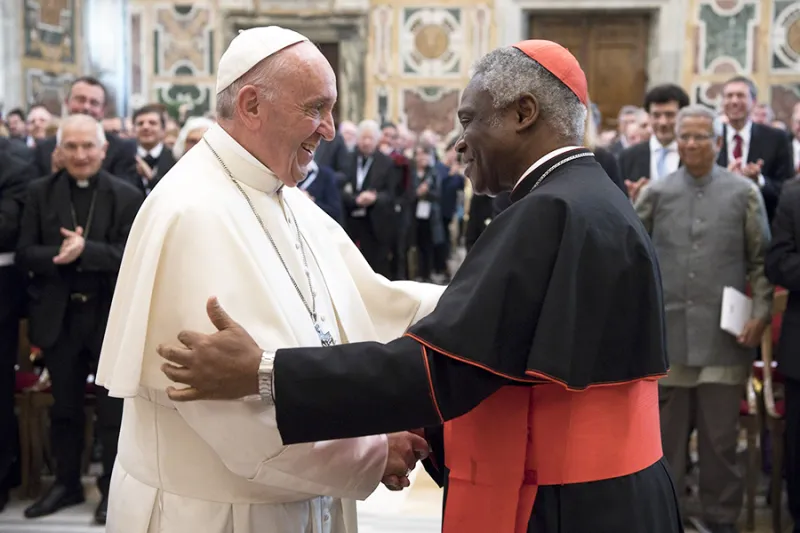 Pope Francis with Cardinal Peter Turkson, prefect of the Dicastery for Promoting Integral Human Development, in the Vatican, Nov. 10, 2017. / L’Osservatore Romano.
Pope Francis with Cardinal Peter Turkson, prefect of the Dicastery for Promoting Integral Human Development, in the Vatican, Nov. 10, 2017. / L’Osservatore Romano.
Vatican City, Nov 17, 2021 / 04:00 am (CNA).
Pope Francis said on Wednesday that the justice and peace commissions of the world’s bishops’ conferences offer an “indispensable service.”
The pope told a meeting of justice and peace commissions on Nov. 17 that they performed the vital tasks of raising awareness of the Catholic Church’s social doctrine and defending human dignity.
“These commissions carry out an indispensable service in the context of the social pastoral care of the local Churches,” the pope said in his message to the two-day online conference hosted by the Vatican Dicastery for Promoting Integral Human Development.
“Indeed, they have the task of spreading and making known the Church’s social doctrine, working actively for the protection of the dignity of the human person and his rights, with a preferential option for the poor and the least.”
“In this way, they contribute to the growth of social, economic and ecological justice, and to the building of peace.”
Conference participants are reflecting on how justice and peace commissions can promote authentic development amid the coronavirus pandemic, drawing inspiration from Pope Francis’ 2015 environmental encyclical Laudato si’ and his 2020 encyclical Fratelli tutti.
The pope recalled that in 1967, in the wake of the Second Vatican Council, Paul VI established the Pontifical Commission “Justitia et Pax,” which John Paul II renamed the Pontifical Council for Justice and Peace in 1988.
In 2017, Pope Francis absorbed the pontifical council into the Dicastery for Promoting Integral Human Development, led by Ghanaian Cardinal Peter Turkson.
The pope welcomed the justice and peace commissions’ focus on his two encyclicals during their Nov. 17-18 meeting.
“Indeed, in every part of the world, integral development, and therefore justice and peace, can be built only through these two paths: care for the common home and fraternity and social friendship,” he said.
“These two paths have their origin in the Gospel of Christ, but they are paths on which we can walk together with many men and women of other Christian confessions, of other religions and even without a specific religious affiliation.”
The pope acknowledged the challenges posed by COVID-19, conflict, and backsliding on human rights.
“The current crisis has revealed numerous contradictions in the economic and political system, while unresolved challenges persist that require the joint efforts of many actors,” he said.
“I urge you, therefore, to address these issues also in collaboration with other ecclesial and civil realities — local, regional, and international — committed to the promotion of justice and peace.”
[…]


